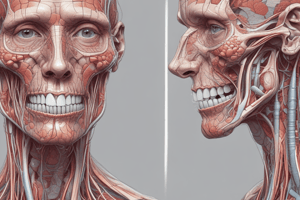Podcast
Questions and Answers
What is the role of the cells lining the striated ducts in salivary gland secretion?
What is the role of the cells lining the striated ducts in salivary gland secretion?
- Secrete potassium and bicarbonate ions (correct)
- Secrete sodium chloride ions and proteins
- Modify saliva as it flows through the intercalated ducts
- Remove sodium chloride ions and proteins
Which statement accurately describes the structure of salivary gland acini?
Which statement accurately describes the structure of salivary gland acini?
- They secrete saliva directly into the bloodstream
- They are enclosed in a fibrous tissue capsule (correct)
- They are surrounded by intercalated ducts
- They contain only mucous cells
How does sympathetic nerve activity affect salivary gland secretion?
How does sympathetic nerve activity affect salivary gland secretion?
- Increases secretion with a higher concentration of serous cells
- Promotes secretion with an increase in protein content
- Causes dry, sticky mouth due to increased saliva production
- Reduces secretion with a higher concentration of mucous cells (correct)
Why does saliva taste relatively salty compared to plasma?
Why does saliva taste relatively salty compared to plasma?
Which salivary gland is the smallest among the major salivary glands?
Which salivary gland is the smallest among the major salivary glands?
What percentage of salivary volume does the sublingual gland produce?
What percentage of salivary volume does the sublingual gland produce?
Which duct system does the greater sublingual gland drain into?
Which duct system does the greater sublingual gland drain into?
Where do the minor salivary glands have their highest concentration in the oral cavity?
Where do the minor salivary glands have their highest concentration in the oral cavity?
Which salivary gland is considered a mixed gland due to its serous and mucous secretions?
Which salivary gland is considered a mixed gland due to its serous and mucous secretions?
Where does the parotid (Stensen) duct enter the oral cavity?
Where does the parotid (Stensen) duct enter the oral cavity?
Which salivary gland accounts for approximately 70% of salivary production?
Which salivary gland accounts for approximately 70% of salivary production?
What substance, produced by the parotid gland, begins the digestion of starches?
What substance, produced by the parotid gland, begins the digestion of starches?
Flashcards are hidden until you start studying
Study Notes
Salivary Gland Secretion
- Cells lining striated ducts reabsorb sodium and secrete potassium ions to modify the electrolyte composition of saliva.
Structure of Salivary Gland Acini
- Salivary gland acini are clusters of 10-20 secretory cells that produce saliva, surrounded by a basement membrane and myoepithelial cells.
Sympathetic Nerve Activity
- Sympathetic nerve activity stimulates salivary gland secretion, particularly the secretion of alpha-amylase from the parotid gland.
Saliva Composition
- Saliva tastes relatively salty compared to plasma because the cells lining the striated ducts reabsorb sodium ions, making saliva more salty.
Salivary Gland Structure and Function
- The smallest major salivary gland is the sublingual gland.
- The sublingual gland produces around 3-5% of salivary volume.
- The greater sublingual gland drains into the submandibular duct system.
- The minor salivary glands have their highest concentration in the oral cavity on the palate.
Parotid Gland
- The parotid gland is considered a mixed gland due to its serous and mucous secretions.
- The parotid (Stensen) duct enters the oral cavity through the buccal mucosa near the second maxillary molar.
- The parotid gland accounts for approximately 70% of salivary production.
- The parotid gland produces alpha-amylase, which begins the digestion of starches.
Studying That Suits You
Use AI to generate personalized quizzes and flashcards to suit your learning preferences.




